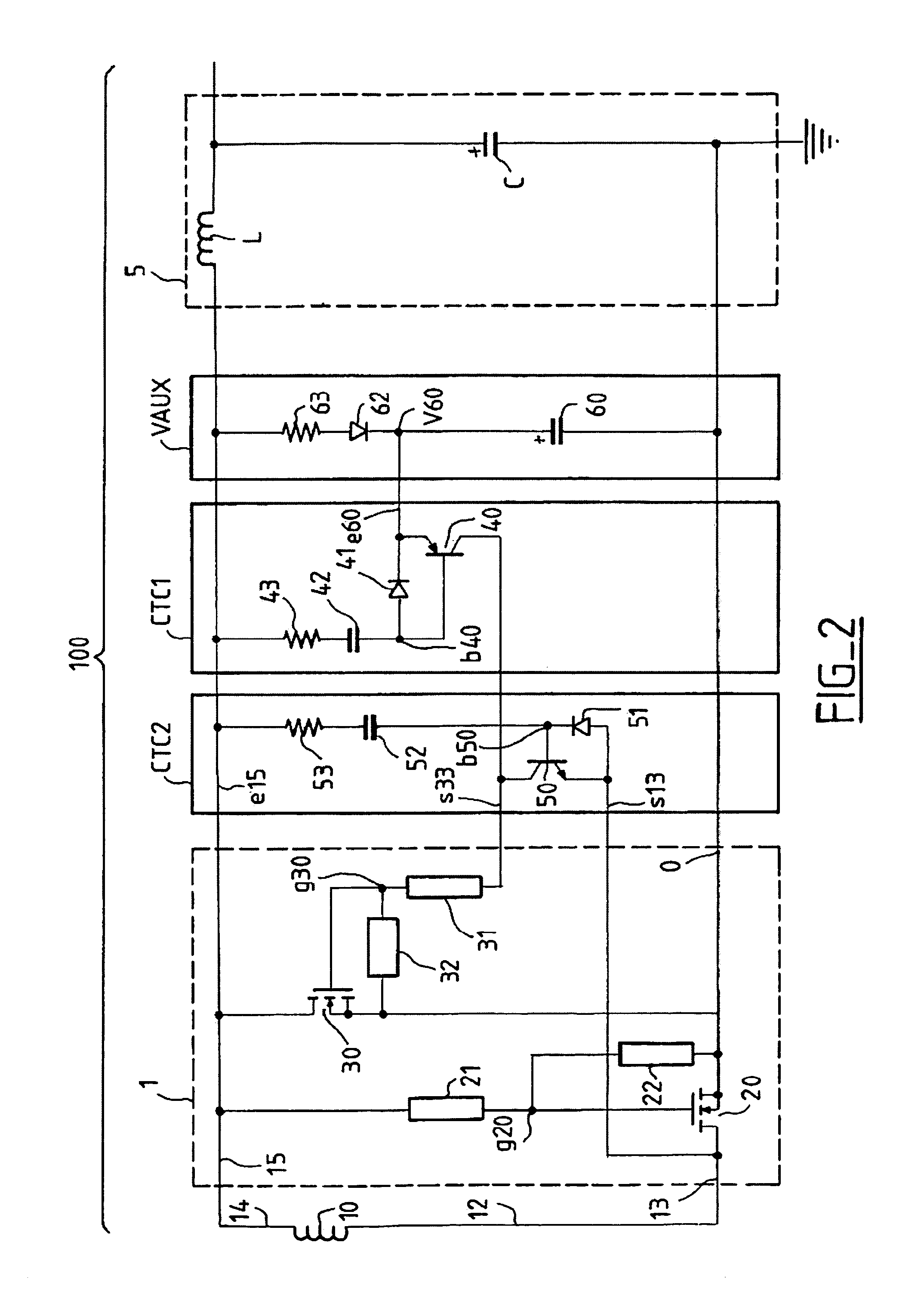Direct energy transfer converter
a converter and direct energy technology, applied in the direction of dc-dc conversion, power conversion system, metabolism disorder, etc., can solve the problems of not being able to achieve control, not being able to find a good compromise, and having a certain number of difficulties
- Summary
- Abstract
- Description
- Claims
- Application Information
AI Technical Summary
Benefits of technology
Problems solved by technology
Method used
Image
Examples
first embodiment
[0062]FIG. 2 represents the secondary part (100) of a direct energy transfer converter (100) according to the invention. Note that the primary part of the converter, which is not represented here, is implemented in a known manner, using a primary winding of a power transformer wired to an input voltage source, by means of switching elements mounted preferentially in direct energy transfer with active clamping.
[0063]Part 100 includes:[0064]a secondary winding (10) of a power transformer,[0065]a synchronous rectifier (1) of the direct energy transfer type,[0066]an LC output filter (5),[0067]means CTC1, called the first charge-transfer circuit,[0068]means CTC2, called the second charge-transfer circuit,[0069]an auxiliary voltage source (VAUX).
[0070]The synchronous rectifier (1) includes two secondary switches in the form of two MOSFET power transistors (20), (direct MOSFET) and (30) (freewheel MOSFET), which respectively implement the direct and freewheel phases of rectifier 1.
[0071]Th...
second embodiment
[0096]FIG. 4 schematically shows the secondary part (100) of a direct energy transfer converter according to the invention.
[0097]This secondary part (100) is identical to that represented on FIG. 2, except that it includes two other charge-transfer circuits (CTC1d and CTC2d), in order to generate the drive for the direct transistor (20), which depends only on the voltage source (VAUX).
[0098]The circuit CTC1d is created in an identical manner to circuit CTC1, and includes:[0099]a bipolar transistor (40d),[0100]a resistance (42d),[0101]a capacitance (42d),[0102]a diode (41d).
[0103]The circuit CTC2d includes:[0104]a MOSFET transistor (50d) called delay transistor,[0105]a capacitance (52d),[0106]a resistance (53d),[0107]a diode (51d).
[0108]The circuit CTC1 operates in an identical manner to circuit CTC1, and provides the charge for the gate of direct transistor 20.
[0109]The resistance 53d has one end connected to the gate of the freewheel transistor (30) via resistance 31, and the other...
third embodiment
[0112]FIG. 5 schematically shows the secondary part (10) of a direct energy-transfer converter, according to the invention.
[0113]The secondary part (100) here includes two power windings (10 and 10b) wired in phase opposition on rectifier transistors 20 and 30, and thus perform “full-wave” asymmetrical synchronous rectification with active clamping. Circuits CTC1, CTC2, CTC1d and CTC2d are created in an identical manner to the circuit shown on FIG. 4, but the synchronisation signals of these circuits change, since the signal available at point 15, the common point of then two windings (10 and 10b), is more or less continuous.
[0114]Thus the synchronisation signal for circuits CTC1 and CTC2 is taken from point 13b connecting the drain of transistor 30 to the end (14b) of winding 10b.
[0115]Likewise, the member 51d, assisting with cut-off of transistor 20, is connected to point 13b.
[0116]As for FIGS. 2 and 4, the charge-transfer circuits, CTC1, CTC2 and CTC1d, are synchronised by vari...
PUM
 Login to View More
Login to View More Abstract
Description
Claims
Application Information
 Login to View More
Login to View More - R&D
- Intellectual Property
- Life Sciences
- Materials
- Tech Scout
- Unparalleled Data Quality
- Higher Quality Content
- 60% Fewer Hallucinations
Browse by: Latest US Patents, China's latest patents, Technical Efficacy Thesaurus, Application Domain, Technology Topic, Popular Technical Reports.
© 2025 PatSnap. All rights reserved.Legal|Privacy policy|Modern Slavery Act Transparency Statement|Sitemap|About US| Contact US: help@patsnap.com



